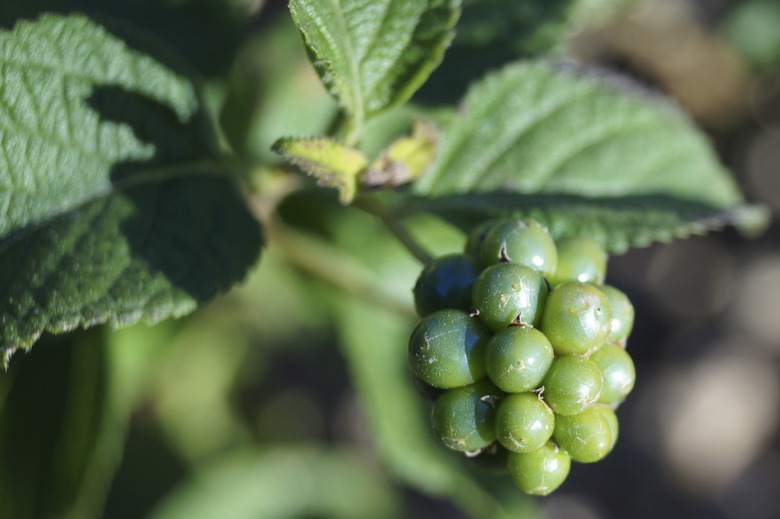What Do Berries On My Lantana Plant Mean?
The berries on a lantana (Lantana spp.), black and about 1/6 of an inch across, are the fruits of the plant. Produced after its 1- to 2-inch clusters of flowers are pollinated, each berry contains one seed. Not all lantanas produce berries, as many of the newer hybrids are sterile. Unless you want to harvest seeds from a fruit-bearing plant, remove the spent flowers before they form berries, as those berries can be toxic. Lantanas, which vary in hardiness from U.S. Department of Agriculture plant hardiness zones 9 through 12, often are treated as annuals in cooler climates.
Lantana Toxicity
All parts of lantana are considered poisonous, though it is more likely to be fatal to animals than to people. Animals may develop sensitivity to light, jaundice and liver damage after eating the plant. The berries are not toxic to birds, which are the main distributors of its seeds. This has helped make the plants invasive.
According to a study in the journal Pediatrics, children can suffer symptoms including nausea and abdominal pain after eating either the plant or its berries, ripe or unripe. Of the 641 children treated, only 65 showed any symptoms at all and "no significant effects and no deaths were recorded." Seek medical help if you think a child ate some parts of a lantana plant.
Dogs and cats that eat lantana leaves or fruits may show some of the same symptoms that children do, but liver damage is not as common in them as it is in farm animals. Rabbits and guinea pigs can suffer the same severe effects from lantana that livestock do. Call your veterinarian for advice if you think your pet ate some of the berries.
Lantana Deadheading
Even if you don't have children or pets that might be tempted by the berries, it's best to deadhead lantana blooms after they wither to extend the plant's flowering season. Once it produces berries, a lantana has accomplished its purpose of reproducing itself, and is likely to stop flowering.
After wiping your pruning shears with a cloth soaked in rubbing alcohol, snip off all of the flower clusters that are past their prime. Cut each one back to the first leaf node beneath it on the stem.
Lantana Seeds
If you want to start lantanas from seed, keep in mind that only the original or species types of the plant — such as common lantana (Lantana camara) or trailing lantana (Lantana montevidensis) — can be counted on to make seedlings which don't vary in appearance from their parent. Seedlings of the cultivars developed from those species, such as "Confetti" (Lantana camara "Confetti") or "Lavender Swirl" (Lantana montevidensis "Lavender Swirl"), both of which grow in USDA zones 9 through 11, won't look identical to the plant from which their seeds were derived.
Wear plastic gloves while handling lantana berries to avoid staining your skin. The leaves can also cause a rash in those with sensitive skin, so it's a good idea to wear them anyway. Harvest those berries when they have ripened to black, and rub them against the mesh of a kitchen strainer to remove the pulp from the seeds. If you don't wish to sow those seeds right away, spread them on a paper towel to dry, after which you can store them in a paper envelope.
Lantana Sowing
Because the germination of lantana seeds may be slow, start them indoors in midwinter about four months before the last spring frost for your zone, immersing them in warm water for 24 hours before you sow them. Fill a pot to within 1/2 inch of its rim with a mixture of 1 part seed sowing mix and 1 part sand. Use a pot that has drainage holes. Space the lantana seeds about 1 inch apart over its surface and cover them with 1/8 inch of the mix.
After covering the pot with plastic wrap, place it in a spot where the temperature remains between 68 and 77 degrees Fahrenheit. If their mix is kept damp, the seeds should germinate within two weeks to two months. Once they sprout, remove the wrap and place the pot on a sunny windowsill or under the center of a grow light.
References
- Southern Sun: A Plant Selection Guide; Jo Kellum
- Queensland Government Department of Agriculture and Fisheries: Lantana Poisoning
- Pediatrics: Ingestion of Lantana Camara Is Not Associated with Significant Effects in Children
- Ladybird Johnson Wildflower Center: Ask Mr. Smarty Plants
- The Complete Guide to Saving Seeds; Robert E. Gough and Cheryl Moore-Gough
- The Pictorial Guide to Seeds of the World; Terry A. Woodger
- Cornell University: Lantana
- Burpee: Deadheading Flowers
- Louisiana State University College of Agriculture: Growing Lantana in Louisiana
- The Plant Book; Susan Page and Margaret Olds, Editors
